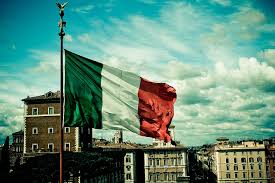Italy: The history of the flag

Rome: The Italian flag, or “Il Tricolore,” is one of the most recognisable flags in the world.
With its trio of green, white, and red splashed across Italian restaurant signs all over the world and printed on T-shirts in tourist kiosks across the country, the Italian flag is an icon of Italy and Italian culture. But stripes of greed, white, and red weren’t always synonymous with Italy.
Where do the colors green, white, and red in the Italian flag come from? Originally designed under Napoleon’s rule, the Italian flag was heavily influenced by another “Tricolore”– the French flag.
Though the national Italian flag would go through many different iterations before becoming what it is today, the colors green, white, and red have been a recurring pattern throughout its history.
Oddly enough, there is no clear answer to what the symbolism is behind the three colors.
There are multiple theories regarding Italy’s Tricolore. One is that the colors carry idealistic significance: green for freedom, white for faith and purity, and red for love.
Others believe that the colors have religious significance, representing the three theological virtues: Green for hope, white for faith, and red for charity.
Another theory is that the colors represent Italy’s geographical landscape and history. Green for the countryside, white for the snowy Alps, and red for the blood of the Italian people shed over the course of Italy’s history.
How long has the Italian flag existed? The Italian flag precedes Italy’s unification. Before unification in 1861, each republic in Italy had a different flag.
When Napoleon began conquering Italian states after the French Revolution began in 1789, he changed the landscape of Italy, creating new republics and destroying former territories.
Following France’s call for national unity, many Italians formed political and military groups to focus efforts on creating unity within their republics.
The colors green, white, and red were originally taken from the civic militia in the Transpadane Republic, an unofficial government in Milan. Militia members wore the colors on their uniforms.
In 1797, the Cispadane Republic in Modena, established by Napoleon, designed its flag with the trio of colors in horizontal stripes and a central emblem.
When the Cispadane Republic merged with nearby regions to create the new Cisalpine Republic, the stripes were rotated counterclockwise to the vertical stripes they are today, with green on the left, white in the middle, and red on the right.
However, this was not the final form of the Italian flag. Later, the short-lived region known as the Italian Republic, located in the north of Italy, also had a green, white, and red flag, but organized in a geometric pattern.
The geometric pattern mirrored patterns from Napoleonic military flags. When the Italian Republic became the Kingdom of Italy, with Napoleon as its emperor, the flag design was slightly altered, and a golden Napoleonic eagle was placed in the center.
When did Italy get an official Italian flag? From 1798 to 1848, the Tricolore was an unofficial symbol of ununified Italian nationalism.
When Napoleon’s rule ended in 1814, a new chapter of Italian history began. Italy was geographically united as one country in 1848, and the Tricolore became a celebrated symbol of Italy.
Many regions began adopting flags that reflected elements of the Tricolore, adding to a sense of national unity. On 23 March 1848, the flag was used by Italian troops in battle against the Austrian army, making it an official symbol of Italian confederation.
The following month, the flag was adopted by the Kingdom of Sardinia. In 1861, it became the official flag of the Kingdom of Italy.
When Italy was officially united as a monarchy under the rule of the Royal House of Savoy in 1861, a shield, cross, and crown were added to the center of the flag’s three stripes.
The shield and cross represented the House of Savoy, and the crown symbolised the monarchy. In 1946, when Italy changed from a monarchy to a republic, the flag returned to the simple, vertical Tricolore.
Finally, the flag legally represented all of Italy, geographically, politically, and historically.
What is the flag of Italy used for in Italy? As well as being a symbol of national unity and pride, the Italian flag is a cherished symbol of Italy’s history and the complicated road to becoming the Italian Republic.
As in many countries, it is illegal to disrespect the Italian flag. Any form of vandalisation or destruction to an Italian flag is considered a crime, and perpetrators risk being fined up to 5000 euro or potential imprisonment.
The Italian flag can be seen hanging outside of government buildings, or being flown on holidays and ceremonial occasions.





